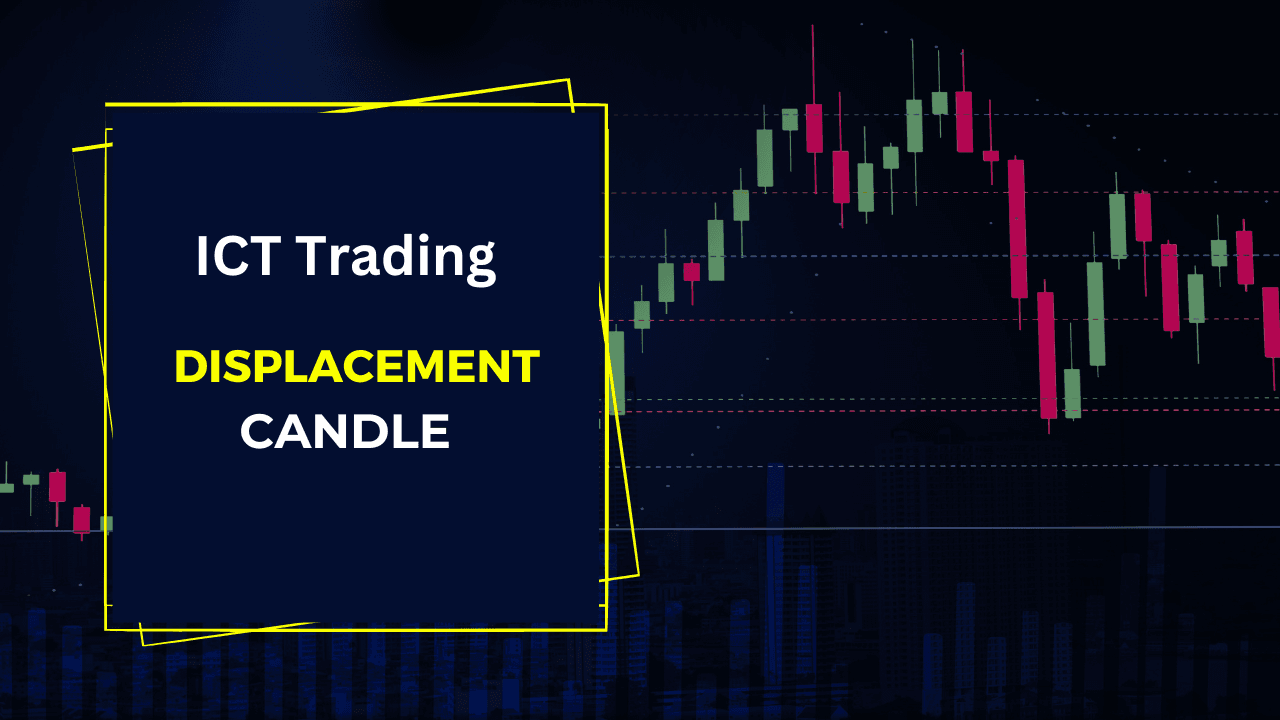In the world of trading, especially within the framework of Inner Circle Trading (ICT), understanding various candlestick patterns is crucial for making informed decisions. One such pattern is the displacement candle, a key indicator that can signal significant price movements and potential reversals. Displacement candles are characterized by their ability to reflect sharp price changes within a short period, highlighting shifts in market sentiment and momentum. In this article, we will explore the concept of displacement candles, their significance in ICT, how to identify them, and practical strategies for incorporating them into your trading approach. Whether you’re a novice trader or an experienced investor, mastering the use of displacement candles can enhance your ability to navigate the complexities of the financial markets.
Introduction to Displacement Candles
Definition of Displacement Candle
A displacement candle is a type of candlestick that exhibits a noticeable shift in price within a specific timeframe. This shift often indicates a strong market movement driven by significant buying or selling pressure. In the context of candlestick analysis, displacement candles can take various forms, but they usually have a long body with little or no wicks, signifying that the price moved decisively in one direction.
The presence of a displacement candle suggests that a market participant has initiated a powerful move, whether it’s a large institutional trader or a significant event impacting market sentiment. Recognizing these candles is essential for traders, as they can provide insights into potential trends and reversals. The ability to identify displacement candles can help traders make informed decisions, improve entry and exit points, and enhance their overall trading strategy.
Importance in Trading
Displacement candles hold significant importance in trading for several reasons. First and foremost, they can indicate strong momentum. When a displacement candle appears, it often shows that the prevailing trend is likely to continue, allowing traders to align their strategies accordingly. For example, if a displacement candle forms in an uptrend, it may signal that buyers are aggressively entering the market, leading to further price increases.
Additionally, displacement candles can act as confirmation signals. When traders observe a displacement candle following a period of consolidation or indecision in the market, it serves as a clear signal that a decisive move is taking place. This can help traders make timely decisions based on the emerging trend, reducing the risk of being caught in a false breakout.
Moreover, displacement candles can also assist traders in identifying support and resistance levels. The price levels at which these candles form often become crucial areas for future price action. By understanding where displacement candles occur, traders can better predict potential price reversals or breakouts.
The Role of Displacement Candles in ICT
How Displacement Candles Fit into ICT Concepts
In Inner Circle Trading (ICT), displacement candles play a pivotal role in understanding market structure and price action. The ICT framework emphasizes the importance of recognizing market phases, which can be supported by the appearance of displacement candles. These candles help traders distinguish between bullish and bearish trends, facilitating a more nuanced approach to market analysis.
Displacement candles align with ICT concepts such as liquidity and order flow. When a displacement candle forms, it often reflects significant activity in the market, suggesting that there is a substantial amount of liquidity available. This insight is crucial for traders, as it allows them to anticipate where price action may move next based on the volume and direction of market orders.
Furthermore, displacement candles can help traders identify potential breakouts or reversals. By observing the context in which these candles occur—such as near key support and resistance levels or following a period of consolidation—traders can gain valuable insights into the likelihood of sustained price movements.
Identifying Displacement Candles
To effectively utilize displacement candles in trading, it’s essential to know how to identify them accurately. Key characteristics of displacement candles include:
- Long Body: A significant price movement with a long candle body, indicating strong buying or selling pressure.
- Minimal Wicks: Little to no upper or lower wicks, suggesting that the price moved decisively in one direction without much retracement.
- Volume Confirmation: Higher-than-average trading volume accompanying the candle, which reinforces the strength of the movement.
Traders can use technical analysis tools to help identify displacement candles on charts. Observing candlestick patterns and applying various indicators can enhance the ability to spot these significant market signals. Recognizing displacement candles in conjunction with other ICT concepts—such as market structure and supply and demand zones—can lead to more effective trading strategies.
Identifying Displacement Candles
Characteristics of Displacement Candles
Identifying displacement candles is crucial for traders looking to enhance their decision-making process. These candles exhibit several distinct characteristics that make them stand out in candlestick charts. Here are the key features to look for:
- Long Candle Body: Displacement candles typically have a long body, indicating a significant price movement within a specific timeframe. This long body demonstrates strong buying or selling pressure, signaling a decisive market move.
- Minimal Wicks: A hallmark of displacement candles is the presence of minimal or nonexistent wicks. When a candle has little to no upper or lower shadows, it indicates that the price has moved strongly in one direction without retracing significantly.
- Volume Confirmation: A displacement candle should ideally be accompanied by increased trading volume. High volume reinforces the validity of the price movement and suggests that the market participants are actively supporting the new price level. Traders should pay attention to volume spikes that coincide with the formation of displacement candles.
- Contextual Analysis: To accurately identify a displacement candle, it’s essential to consider its context within the broader market structure. Look for displacement candles that appear at critical points, such as support or resistance levels, following a period of consolidation or after significant news announcements.
Understanding these characteristics allows traders to effectively spot displacement candles on their charts and make informed trading decisions.
How to Use Displacement Candles in Your Trading Strategy
Entry and Exit Points
Incorporating displacement candles into your trading strategy can significantly enhance your entry and exit points. Here’s how to do it:
- Identifying Entry Points: When you spot a displacement candle, it can serve as a potential entry signal. If the displacement candle forms in the direction of the prevailing trend (e.g., an upward displacement candle in a bullish market), consider entering a trade shortly after the candle closes. This indicates that the market momentum is likely to continue.
- Setting Stop-Loss Levels: Placing a stop-loss order is vital for managing risk. A common practice is to set your stop-loss just beyond the low of a bullish displacement candle or the high of a bearish displacement candle. This strategy helps protect your investment in case the market reverses unexpectedly.
- Determining Exit Points: Use displacement candles to set exit points as well. If a displacement candle appears at a significant resistance level while you’re in a long position, it might indicate a good opportunity to take profits. Conversely, if you’re in a short position and a displacement candle forms at a support level, consider exiting your trade to lock in gains.
Combining with Other ICT Tools
For optimal results, it’s beneficial to combine displacement candles with other ICT tools and concepts. Here are some strategies for integrating displacement candles into a broader trading plan:
- Market Structure Analysis: Displacement candles work best when viewed through the lens of market structure. Assess the overall trend and look for displacement candles that align with higher highs and higher lows in an uptrend, or lower highs and lower lows in a downtrend. This alignment can confirm the strength of the trend.
- Support and Resistance Levels: Utilize displacement candles in conjunction with key support and resistance levels. If a displacement candle forms near a support level in a bullish trend, it can serve as a strong buy signal. Conversely, if it appears near resistance, it may indicate a potential sell signal.
- Combining with Other Candlestick Patterns: Look for confluences with other candlestick patterns. For instance, if a displacement candle follows a bullish engulfing pattern, it reinforces the bullish sentiment. Combining these patterns can provide additional confirmation for your trades.
- Using Technical Indicators: Integrating technical indicators such as Moving Averages or Relative Strength Index (RSI) with displacement candles can enhance decision-making. For example, if a displacement candle aligns with a Moving Average crossover, it may signal a stronger trend.
By effectively using displacement candles in your trading strategy, you can improve your ability to enter and exit trades, manage risk, and enhance overall trading performance.
Common Mistakes to Avoid
Misinterpretation of Displacement Candles
One of the most common mistakes traders make is misinterpreting displacement candles. It’s essential to remember that not every long-bodied candle indicates a displacement candle. Traders should consider the context in which the candle forms. For instance, a long candle appearing during low volatility or low volume periods may not signify a strong market move. Always analyze displacement candles in conjunction with other market signals to avoid false assumptions.
Another pitfall is focusing solely on displacement candles without considering other factors. Traders who rely on displacement candles in isolation may miss critical information that could impact their trades. For example, a displacement candle formed during a market reversal could lead to unexpected losses if not analyzed within the broader market context.
Ignoring Market Context
Ignoring the overall market context is another significant mistake. Displacement candles can provide valuable insights, but they should not be viewed in a vacuum. Traders must consider market conditions, such as economic news, geopolitical events, and overall sentiment. A displacement candle that appears strong may still be vulnerable to reversal if there is adverse news affecting the market. Keeping an eye on market trends, liquidity, and trader sentiment can prevent traders from making hasty decisions based solely on displacement candles.
Additionally, neglecting to assess other technical indicators alongside displacement candles can lead to poor trading outcomes. For instance, a displacement candle may appear bullish, but if the RSI indicates overbought conditions, it might be wise to exercise caution. Always take a holistic approach to trading, integrating various analytical tools to avoid common pitfalls associated with displacement candles.
Conclusion
In conclusion, displacement candles are powerful tools within the Inner Circle Trading (ICT) framework that can enhance a trader’s ability to navigate the financial markets. By understanding their characteristics, traders can identify key signals that indicate strong market momentum and potential reversals. However, it’s crucial to avoid common mistakes, such as misinterpreting these candles and ignoring the broader market context.
To successfully leverage displacement candles in your trading strategy, consider integrating them with other ICT concepts, such as market structure, support and resistance levels, and relevant technical indicators. By doing so, you can make more informed decisions and improve your overall trading performance. Mastering displacement candles not only enhances your trading skills but also allows you to capitalize on market opportunities with greater confidence.
Read More SMT Divergence Meaning in Trading
Frequently Asked Questions
What is the best timeframe to use displacement candles?
The best timeframe to use displacement candles depends on your trading style. For day traders and scalpers, shorter timeframes such as 1-minute or 5-minute charts can provide timely signals. Swing traders may find it more beneficial to use displacement candles on 15-minute, hourly, or daily charts, allowing for a better understanding of the overall market trend. Ultimately, it’s essential to choose a timeframe that aligns with your trading strategy and risk tolerance.
How do displacement candles compare to other candlestick patterns?
Displacement candles differ from other candlestick patterns, such as doji, engulfing, or hammer patterns, primarily in their indication of market momentum. While other candlestick patterns often signal potential reversals or indecision in the market, displacement candles signify strong price movement in one direction. Traders should consider combining displacement candles with other candlestick patterns to gain a comprehensive view of market dynamics.
What role does volume play in confirming displacement candles?
Volume is a crucial factor in confirming the validity of displacement candles. When a displacement candle is accompanied by high trading volume, it reinforces the strength of the price movement and indicates strong market interest. Low volume during the formation of a displacement candle may suggest that the move is less significant and could lead to false signals. Always look for volume spikes alongside displacement candles to confirm their reliability.
Can displacement candles predict market reversals?
Displacement candles can signal potential market reversals, but they should not be relied upon as the sole indicator. While a displacement candle may indicate strong momentum, it’s crucial to analyze the broader market context, including support and resistance levels and other technical indicators. Using displacement candles in conjunction with other trading tools can enhance your ability to predict reversals more accurately.


